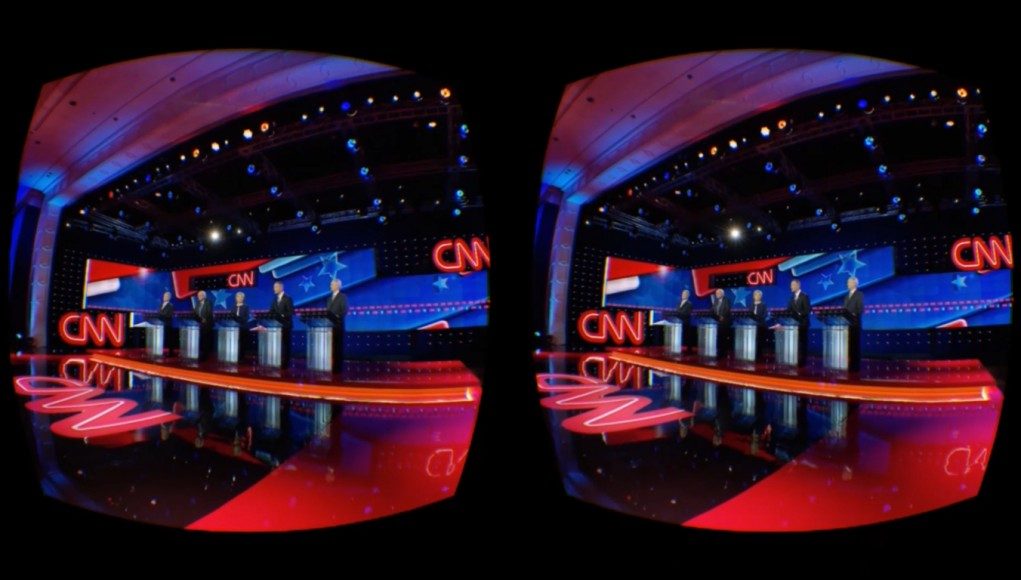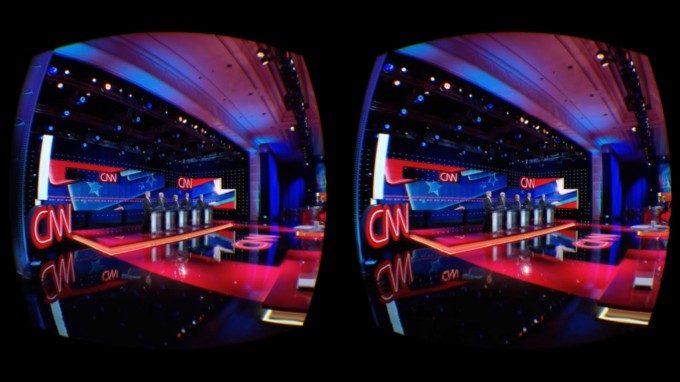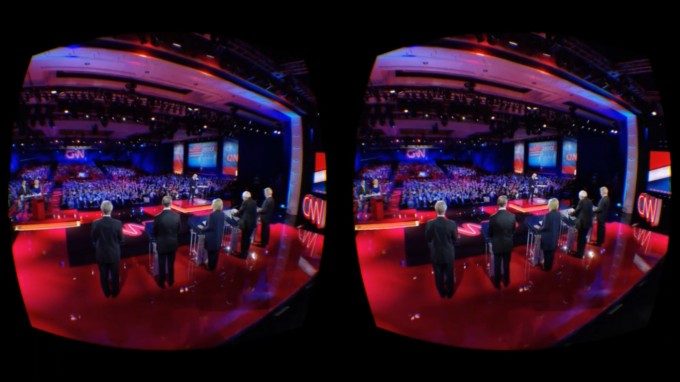The first Democratic presidential debate of this election cycle is over, and while the 24-hour news organizations decide who won (you can win? are there prizes?), it’s a middling victory for immersive video, and only just.
NextVR partnered with CNN to livestream the debate, which was held at 8:30pm EDT Tuesday in Las Vegas. It was in fact the first political debate ever transmitted live to VR headsets, specifically the Samsung Gear VR mobile platform, which was announced after a trial run with the Republican debate early last month.
And I sat through the whole thing. All two and half hours, save a few breaks for a battery recharge and a cool down. And while I’m about as apolitical as it gets, I didn’t entirely hate it.
There’s only a few occasions when I wear a VR headset for more than two hours straight at a time, and those usually involve social VR spaces where the name of the game is interaction as much as it is distraction. After an extended time in DK2-compatible online spaces like Altspace or Convrge, or even an engaging film in my Gear VR, I inevitably hit a breaking point where I unconsciously prop up the headset with a hand to relieve the stress on my poor nose and cheek bones. This is because the ergonomics on the first and second generation developer kits are tantamount to a very front-heavy pair of ski goggles, but because I like being in VR more than I value my own temporary comfort, I thought that watching a debate—albeit the most boring thing I can possibly think of—wouldn’t be that much different.
See Also: NextVR Raises $5 Million for Live VR Broadcast Tech, Content to Come Pre-loaded on Samsung Gear VR
Determined to watch the entire Democratic debate without even the help of a nifty drinking game to bide my time between the well-prepped responses (sober for science), I popped on my Note 4 Gear VR and loaded up the NextVR app just in time to see the introductions of the night’s candidates: Hillary Clinton, Bernie Sanders, and three other guys (aka Lincoln Chafee, Jim Webb, and Martin O’Malley).
The stream, which featured four different vantage points, was very smooth and had exceptional audio. The 3D 180-degree video was the best I’ve ever seen up until now, and although it was only 180 as opposed to a full 360 sphere, the placement made you forget that there wasn’t anything behind you. The perceived resolution however, like Chafee’s haircut, left much to be desired.
Resolution is a hard thing to knock NextVR on, simply because the Note 4 Gear VR’s 1280 x 1440 per-eye-resolution is a clear limitation. You can only pack in so much detail into Anderson Cooper’s face (the easiest to recognize) when it’s only 10 pixels wide and 15 high, making it nearly impossible to make out facial features from the distances. I felt like the grandiosity of the set stole much of my attention from the 5 little people on stage, and that the whole affair eventually became slowly more than my nose bridge could handle after the hour and a half mark.
All of this is annoying, but very familiar to anyone who’s spent more than an hour strapped into a VR headset—and while ergonomics have improved vastly for each of the rapidly approaching consumer headsets; Oculus Rift, HTC Vive, and Playstation VR, the question remains of whether you actually want to sit and watch this sort of content even when extended comfort is no longer an issue. Seriously. We don’t know.
Granted, it’s easy to wrap all of the current problems in VR into one—be it the lack of comfort, sub-par resolution, or inherent loneliness of the immersive video experience—and call immersive video “not ready for prime time.” But there’s something important we’re forgetting here, that these are nascent mediums and they need a full support structure in order to grow. Capturing and streaming is just one important aspect of creating something worth watching. I can’t speak for NextVR, but I’m betting they weren’t allowed to plop one of their rigs center stage so we could get a better view of the speakers, nor were they allowed any time in the backrooms that might draw VR headset owners into some of the exclusive behind-the-scenes action like with NextVR’s NBA coverage. Above all, there’s also a clear need for the media to understand that VR is not here to replace TV, just as TV wasn’t meant to replace radio (and still hasn’t).
I’m with Stephen Colbert when he lampoons the entire political spectacle, because maybe a lackluster show with 5 lizardpeople standing on a stage isn’t the ideal way to show off a technology that can let you connect and learn in new ways never before seen. So while immersive video and VR may not be ready for everyone just yet, concatenating the two and calling them a collective failure is just disingenuous.









